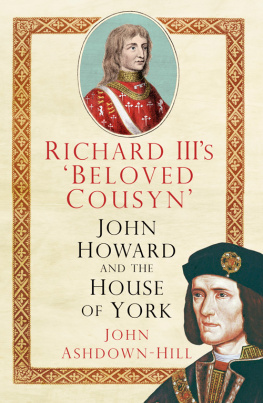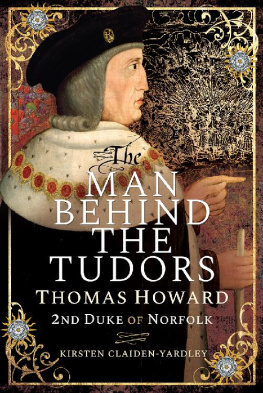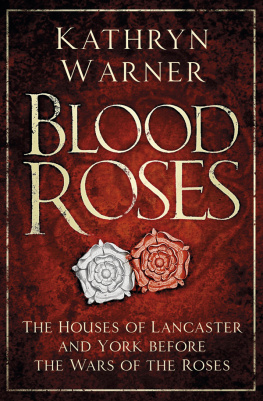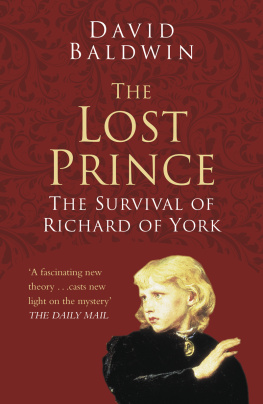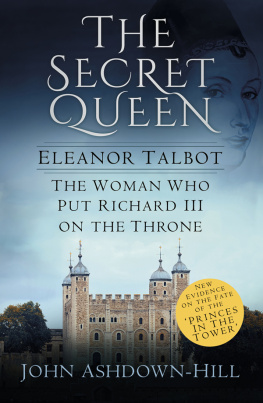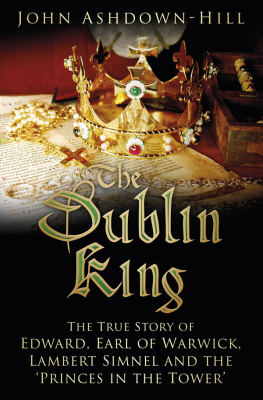
To my friends, the Canonesses Regular of the Holy Sepulchre in Colchester, who helped me to commemorate John Howard and his men at St Johns Abbey, and especially to Sister Stephanie, who took a special interest in my progress, and Sister Mary Stephen, who is one of John Howards descendants.
My grateful thanks for their kind and invaluable assistance are due to the staff of the Essex Record Office, the Suffolk Record Office (Ipswich branch), the British Library, the archival and library staff of His Grace the Duke of Norfolk at Arundel Castle, and the library staff of the Society of Antiquaries of London. I also owe a considerable debt of gratitude to Dr Chris Thornton, who supervised my PhD research, and to the members of my supervisory board: Dr Joan Davies and Dr Herbert Eiden. My thanks also go to Annette Carson and Dave Perry, who kindly read draft versions of the text, and corrected typographical and other errors; and likewise to Cath DAlton and Geoff Wheeler who supplied illustrations. I should also like to thank my PhD examiners, Professor Anne Curry and Professor John Walters, without whose encouragement I might never have attempted to make parts of my thesis more widely available in the form of this book.
Contents
The Gregorys Dispute: Cecily Nevilles Draft Letters |
Parliamentary Representatives for Ipswich and Colchester during the Yorkist Period |
1483: The Calendar o f the Year o f the Three Kings |
Man-at-Arms o f Known origin in North Essex and South Suffolk, Contracted to Serve John Howard in the 1480s |
BL | British Library |
BM | British Museum |
B.OB | W.G. Benham, ed., Colchester Oath Book |
CCCC | Corpus Christi College, Cambridge |
CHM | Calendar o f Muniments , Harwich |
CP | G.E. Cockayne, The Complete Peerage , London, 191059 |
CPR | Calendar o f Patent Rolls |
Cr. Chr . | N. Pronay and J. Cox, eds, T he Crowland Chronicle continuations 14591486 , London, 1986 |
ERO | Essex Record Office |
Gothic | R. Marks & P. Williamson, eds, Gothic, Art for England 14001547 , London: V&A, 2003 |
HHB | A. Crawford, ed., Howard Household Books , Stroud, 1992 |
HM | Harwich Muniments |
HP Biog . | J.C. Wedgwood and A.D. Holt, History o f Parliament 14391509 Biographies o f the Members o f the Commons House |
IRO | Suffolk Record Office (Ipswich Branch) |
J.Ch. | I.H. Jeayes, ed., Descriptive Catalogue o f a Collection o f Charters sometime preserved at Giffords Hall in Stoke-by-Nayland, Co. Suffolk , unpublished, IRO, S 347 |
Mancini | C.A.J. Armstrong, ed., Dominic [ sic ] Mancini, The Usurpation o f Richard III, Gloucester, 1984 |
MEJ | R.W. Lightbown, Mediaeval European Jewellery , London:V&A, 1992 |
NPG | National Portrait Gallery |
ODNB | Oxford Dictionary o f National Biography |
PL | N. Davis, Paston Letters and Papers o f the fifteenth century , 2 vols, Oxford, 1971; 1976 |
PPE | N.H. Nicolas, ed., Privy Purse Expenses o f Elizabeth o f York & Wardrobe Accounts o f Edward IV , London: W. Pickering, 1830; reprinted London: F. Muller, 1972 |
R3MK | A. Carson, Richard III, the Maligned King , Stroud 2008 |
Ric. | The Ricardian |
Road | P.W. Hammond and A.F. Sutton, Richard III the Road to Bosworth Field , London, 1985 |
Soc. Ant. | The Society of Antiquaries of London |
TNA | The National Archive [formerly PRO] |
V&A | Victoria and Albert Museum |
VCH | Victoria County History |
WRO | Warwickshire Record Office |
Q | J. Ashdown-Hill, The client network, connections and patronage of Sir John Howard (Lord Howard, first Duke of Norfolk) in north-east Essex and south Suffolk, unpublished PhD thesis, University of Essex, 2008 |
This book arose largely out of research for my PhD thesis. The latter was essentially local in its focus, concentrating in detail upon John Howards client network and patronage in north Essex and south Suffolk. But inevitably it also considered John Howards national importance. Reviewing Howards service to and relationship with the Yorkist kings produced new evidence, new interpretations and new perspectives, and these form the basis of the present study.
Although the presentation of material is sequential within each chapter and in general terms, within the book as a whole a complete chronological account of John Howards career was not my aim. The individual chapters are thematic in their approach, while the overarching purpose of the book is to examine every aspect of John Howards relationship with the ruling house of York.
Studying those men and women who were key figures in the entourage of the Yorkist kings is of interest in its own right, but it also has the potential to shed new light upon the enigmas of the period. Certainly, through this study, we discover much about John Howard himself: his technological awareness, the state of his health, his leisure activities, his government service, his relationship with the royal family and others, his beliefs, and perhaps something of his character. But at the same time hopefully a clearer picture also emerges of the Yorkist era as a whole. As a result of the evidence presented here we can now accord due credit (perhaps for the first time) to Edward IVs role in building up the navy, and the reader is invited to reconsider the standard assessment of Edwards character.
At the same time, new light is shed on the key events of 1483 and the accession of Richard III, as these are re-examined in minute detail in the light of John Howards day-to-day experience of the course of events.
All my references to John Howards surviving household accounts give details of the original manuscript source as well as the more readily accessible 1992 published transcripts. This is because the latter contain a few errors of transcription, a number of discrepancies in folio numbering, and a few omissions (full details of which can be found in Q, appendix 1).
Conventions
The following conventions have been adopted:
Spelling
In quotations from medieval sources, unless othersise stated, original spellings have been retained, including use of yogh (  = g or y) and thorn ( = th).The third defunct Old- and Middle-English letter, eth ( = th), does not occur in any of the quoted texts. Standard abbreviations have been expanded without comment. Some punctuation has been modernised.
= g or y) and thorn ( = th).The third defunct Old- and Middle-English letter, eth ( = th), does not occur in any of the quoted texts. Standard abbreviations have been expanded without comment. Some punctuation has been modernised.
Dates
In the fifteenth century the calendar year in England began on Lady Day (25 March), and not on 1 January. Therefore, for dates falling between 1 January and 24 March the usual convention is followed. February 1464/5 means February 1464 (medieval calendar) or February 1465 (modern calendar).
Next page
